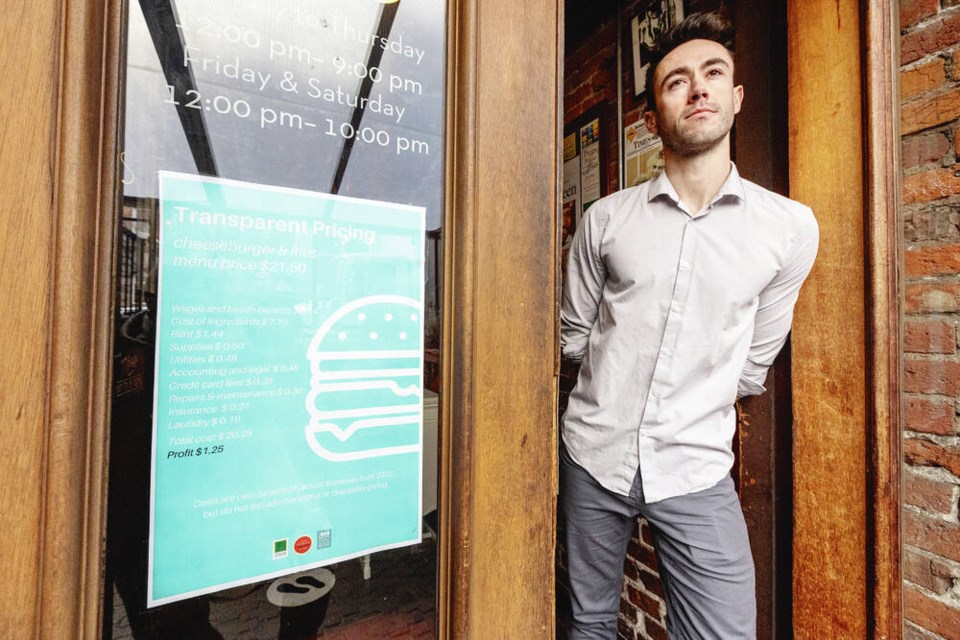Want to know why your cheeseburger and fries cost $21.50?
Dave Craggs just broke it down in a poster on the front door of Ferris’ Grill and Garden Patio:
• Wages and health benefits: $9.14
• Ingredients: $7.10
• Rent: $1.44
• Supplies: 50 cents
• Utilities: 48 cents
• Accounting and legal: 45 cents
• Credit card fees: 38 cents
• Repairs and maintenance: 36 cents
• Insurance: 21 cents
• Laundry: 19 cents
• Total cost: $20.25
• Profit: $1.25
OK, Craggs says, maybe that $7.10 ingredients figure is a little high for a cheeseburger. But it is representative of how much the cost of food, as a proportion of the price, typically adds to a dish at his Yates Street restaurant.
Also, the numbers on the poster came from 2022, when costs were lower than they are today, and didn’t include other outlays such as marketing or charitable giving, so the bottom line is pretty close.
Why tape the burger breakdown to the door? To be transparent about why restaurants are raising menu prices.
“It’s not because restaurants are being greedy and trying to make more money,” Craggs says. They’re just trying to survive.
Ian Tostenson, CEO of the B.C. Restaurant and Foodservices Association, echoes this concern. The pace of food inflation might have slowed from double digits to single, but costs are still rising. It’s not as though restaurants are exempt from the sticker shock we’re all feeling at the grocery store.
Also, labour bills have gone up, and not just because of the wage inflation tied to the lack of workers. (B.C. restaurants should be employing 190,000 people, Tostenson says, but are running 30,000 to 35,000 short.) The provincial government has added to restaurants’ plates (as it were) by ladling on costs like the Employer Health Tax, which it brought in to replace Medical Services Plan premiums in 2019, and the new requirement for five days of paid sick leave. It also raised the minimum wage, not that many people in full-service restaurants — at least, not those employees whose pay doesn’t also include tips — earn that little.
Tostenson doesn’t argue against these measures. It’s just that the government imposed them without showing much appreciation for how precarious things already were for restaurants, many of which piled up debt while trying to stay afloat during the pandemic, he said. “It’s not over for us. We’re not back to normal.”
He cited one example of where government could help. The province has a certification process for restaurants that want to employ skilled foreign workers. A good idea, Tostenson says, but there’s a backlog of weeks, if not months, meaning we’re losing those workers to competing jurisdictions that cut the red tape faster. Solve that, Tostenson says, and it will help offset the daunting demographics of greying British Columbia, where there are only two new workers for every three who retire. “We just don’t have enough people.”
What does all that mean to you, the consumer? A $21.50 burger. Add five per cent tax to a couple of those, then factor in a tip, and your lunch bill is north of $50, even if you’re only drinking water. Gulp.
Craggs is well aware of the tightrope he’s walking at Ferris’, a Yates Street institution for 32 years. Charge too little and the profit is gone. Charge too much and the customer disappears altogether, particularly at a time of rising interest rates in an over-mortgaged city. “You have to be very careful about raising prices, because there’s a lack of dining money out there.”
But what is he supposed to do when the canola oil that cost $20 in 2019 now goes for $50, the yams that were $25.90 are $60, and tinned tomatoes that were $30-$35 now sell for $50-$100? What to do when takeout containers have doubled since the pandemic, the health tax costs $40,000 and insurance has soared?
That’s all he’s trying to say by telling customers why a cheeseburger in paradise costs $21.50.
“I’m just pointing out the impact on small business,” he says.
>>> To comment on this article, write a letter to the editor: [email protected]




